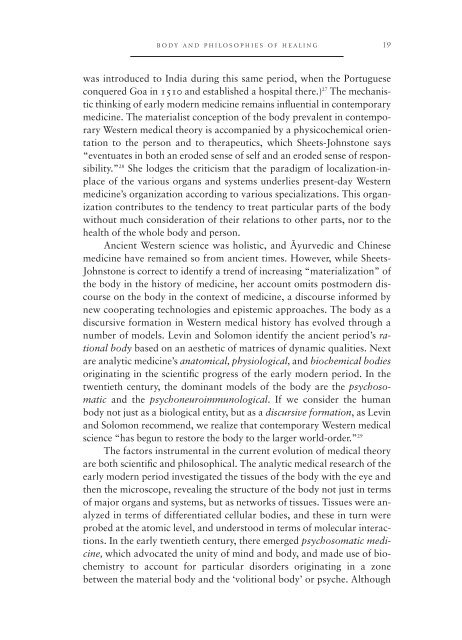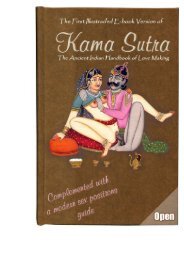body and health in yoga, Ayurveda, and Tantra
body and health in yoga, Ayurveda, and Tantra
body and health in yoga, Ayurveda, and Tantra
You also want an ePaper? Increase the reach of your titles
YUMPU automatically turns print PDFs into web optimized ePapers that Google loves.
ody <strong>and</strong> philosophies of heal<strong>in</strong>g 19<br />
was <strong>in</strong>troduced to India dur<strong>in</strong>g this same period, when the Portuguese<br />
conquered Goa <strong>in</strong> 1510 <strong>and</strong> established a hospital there.) 27 The mechanistic<br />
th<strong>in</strong>k<strong>in</strong>g of early modern medic<strong>in</strong>e rema<strong>in</strong>s <strong>in</strong>fluential <strong>in</strong> contemporary<br />
medic<strong>in</strong>e. The materialist conception of the <strong>body</strong> prevalent <strong>in</strong> contemporary<br />
Western medical theory is accompanied by a physicochemical orientation<br />
to the person <strong>and</strong> to therapeutics, which Sheets-Johnstone says<br />
“eventuates <strong>in</strong> both an eroded sense of self <strong>and</strong> an eroded sense of responsibility.”<br />
28 She lodges the criticism that the paradigm of localization-<strong>in</strong>place<br />
of the various organs <strong>and</strong> systems underlies present-day Western<br />
medic<strong>in</strong>e’s organization accord<strong>in</strong>g to various specializations. This organization<br />
contributes to the tendency to treat particular parts of the <strong>body</strong><br />
without much consideration of their relations to other parts, nor to the<br />
<strong>health</strong> of the whole <strong>body</strong> <strong>and</strong> person.<br />
Ancient Western science was holistic, <strong>and</strong> Åyurvedic <strong>and</strong> Ch<strong>in</strong>ese<br />
medic<strong>in</strong>e have rema<strong>in</strong>ed so from ancient times. However, while Sheets-<br />
Johnstone is correct to identify a trend of <strong>in</strong>creas<strong>in</strong>g “materialization” of<br />
the <strong>body</strong> <strong>in</strong> the history of medic<strong>in</strong>e, her account omits postmodern discourse<br />
on the <strong>body</strong> <strong>in</strong> the context of medic<strong>in</strong>e, a discourse <strong>in</strong>formed by<br />
new cooperat<strong>in</strong>g technologies <strong>and</strong> epistemic approaches. The <strong>body</strong> as a<br />
discursive formation <strong>in</strong> Western medical history has evolved through a<br />
number of models. Lev<strong>in</strong> <strong>and</strong> Solomon identify the ancient period’s rational<br />
<strong>body</strong> based on an aesthetic of matrices of dynamic qualities. Next<br />
are analytic medic<strong>in</strong>e’s anatomical, physiological, <strong>and</strong> biochemical bodies<br />
orig<strong>in</strong>at<strong>in</strong>g <strong>in</strong> the scientific progress of the early modern period. In the<br />
twentieth century, the dom<strong>in</strong>ant models of the <strong>body</strong> are the psychosomatic<br />
<strong>and</strong> the psychoneuroimmunological. If we consider the human<br />
<strong>body</strong> not just as a biological entity, but as a discursive formation, as Lev<strong>in</strong><br />
<strong>and</strong> Solomon recommend, we realize that contemporary Western medical<br />
science “has begun to restore the <strong>body</strong> to the larger world-order.” 29<br />
The factors <strong>in</strong>strumental <strong>in</strong> the current evolution of medical theory<br />
are both scientific <strong>and</strong> philosophical. The analytic medical research of the<br />
early modern period <strong>in</strong>vestigated the tissues of the <strong>body</strong> with the eye <strong>and</strong><br />
then the microscope, reveal<strong>in</strong>g the structure of the <strong>body</strong> not just <strong>in</strong> terms<br />
of major organs <strong>and</strong> systems, but as networks of tissues. Tissues were analyzed<br />
<strong>in</strong> terms of differentiated cellular bodies, <strong>and</strong> these <strong>in</strong> turn were<br />
probed at the atomic level, <strong>and</strong> understood <strong>in</strong> terms of molecular <strong>in</strong>teractions.<br />
In the early twentieth century, there emerged psychosomatic medic<strong>in</strong>e,<br />
which advocated the unity of m<strong>in</strong>d <strong>and</strong> <strong>body</strong>, <strong>and</strong> made use of biochemistry<br />
to account for particular disorders orig<strong>in</strong>at<strong>in</strong>g <strong>in</strong> a zone<br />
between the material <strong>body</strong> <strong>and</strong> the ‘volitional <strong>body</strong>’ or psyche. Although



